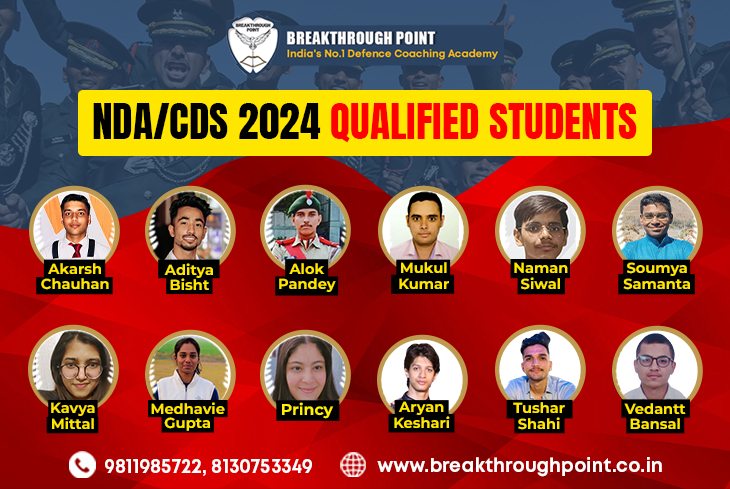Q1. What is the CDS (Combined Defence Services) exam?
+
The CDS exam held twice a year by UPSC chooses graduates for induction in IMA, INA, AFA, and OTA. It consists of two phases: the written exam and the SSB interview along with medicals. We offer full CDS coaching with specialized training for the written exam as well as SSB preparation at Breakthrough Point, making candidates prepared for all phases of selection.
Q2. Who can apply for the CDS exam?
+
Any graduate (or final-year student) who fulfills age restrictions — IMA/INA: 19–24 years, AFA: 20–24 years, OTA: 19–25 years - is eligible to apply. The nationality, marital status, and subject requirements differ for each academy. Breakthrough Point provides individualized eligibility counseling to assist aspirants, check their requirements, and assist them in selecting the suitable academy option while applying.
Q3. What is the CDS exam pattern and marking scheme?
+
For IMA, INA, and AFA, there are three papers: English, General Knowledge, and Elementary Mathematics (each of 100 marks, 300 in total). For OTA, English and General Knowledge alone are needed (200 in total). There is negative marking (⅓ mark) for incorrect answers. Breakthrough Point conducts CDS mock tests on the same UPSC pattern, imparting time management and answer accuracy through repeated practice sessions.
Q4. How to apply for the CDS exam?
+
Online applications are done on the UPSC website. Documents have to be uploaded, details entered cautiously, and fee paid. At Breakthrough Point, guides lead applicants step-by-step through filling up the application form, photo/signature upload, and document checking.
Q5. What happens after the written exam — what is the SSB process?
+
Eligible applicants undergo the five-day SSB process, namely Stage-I (OIR + PPDT), Stage-II (psychology, GTO tasks, interview), and medicals. Breakthrough Point offers personalized SSB coaching with live practice sessions, mock interviews, psychology training, and GTO ground exposure to enable aspirants to feel confident and enhance their chances of selection.
Q6. What are CDS physical and medical standards?
+
Applicants are required to satisfy service-specialized criteria for height, weight, vision, endurance, and general health. These are rigorously screened by the Service Medical Board. Breakthrough Point offers physical fitness training as well as medical requirement guidance so that students can prepare in advance and not get disqualified.
Q7. Can one crack CDS without coaching?
+
Yes, self-study with NCERTs, standard books, and regular practice can certainly do the trick. But success is also many times dependent on expert strategy and direction. Breakthrough Point's systematic CDS program offers experienced faculty, study material, doubt-clearing sessions, and integrated SSB training, enhancing the chances of success in the very first attempt.
Q8. Which books and resources should I pursue for CDS preparation?
+
Recommended books are NCERTs (Maths, Science, History, Geography), English grammar books, Lucent's GK, and UPSC's old year papers. Breakthrough Point adds to these with CDS exclusive study notes, practice sheets, full-length mocks, and individual feedback, which provide hopefuls a sharper cut in preparation.
Q9. What is the final CDS merit / cutoff determined by?
+
The last merit list is prepared on marks scored in the written test (300 for IMA/INA/AFA, 200 for OTA) combined with SSB interview (300), with medical fitness being mandatory. Breakthrough Point's emphasis on both written and SSB ensures that candidates score well on both, giving them maximum opportunities to find a place on the merit list.
Q10. Why Breakthrough Point for CDS coaching?
+
Breakthrough Point provides end-to-end CDS coaching: coverage of syllabus, weekly mock tests, physical training, SSB coaching, and individual mentorship. Our innovative combination of written exam training with SSB coaching positions us among the most reliable CDS coaching institutes for candidates who are committed to final selection.


